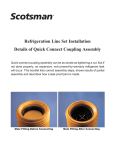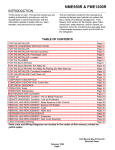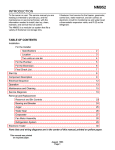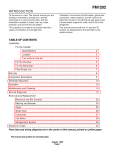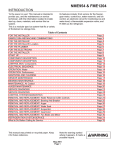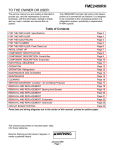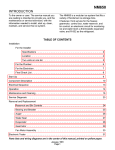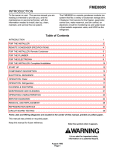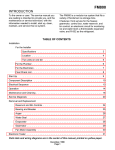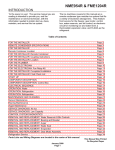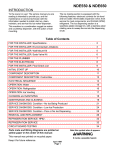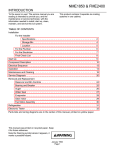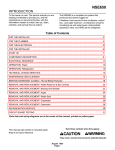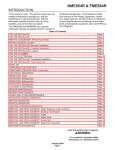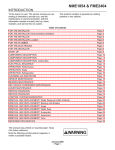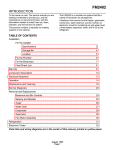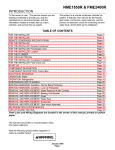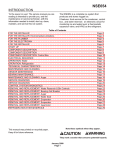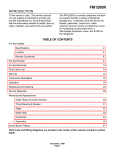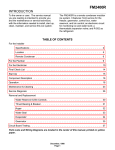Download NME950 & FME1200
Transcript
NME950 & FME1200 INTRODUCTION To the owner or user: The service manual you are reading is intended to provide you, and the maintenance or service technician, with the information needed to install, start up, clean, maintain, and service this ice system. This machine is a modular ice system that fits a variety of Scotsman ice storage bins. It features: front service for the freezer, gear motor, control box, water reservoir, and bin control; an electronic circuit for monitoring ice and water level; a thermostatic expansion valve; and R-404A as the refrigerant. TABLE OF CONTENTS FOR THE INSTALLER . . . . . . . . . . . . . . . . . . . . . . . . . . . . . . . . . . . Page 2 SAMPLE BIN AND MACHINE COMBINATIONS . . . . . . . . . . . . . . . . . . . . . . Page 3 FOR THE INSTALLER . . . . . . . . . . . . . . . . . . . . . . . . . . . . . . . . . . . Page 4 FOR THE PLUMBER . . . . . . . . . . . . . . . . . . . . . . . . . . . . . . . . . . . . Page 6 FOR THE ELECTRICIAN . . . . . . . . . . . . . . . . . . . . . . . . . . . . . . . . . . Page 7 START UP Page 9 . . . . . . . . . . . . . . . . . . . . . . . . . . . . . . . . . . . . . . . . COMPONENT DESCRIPTION . . . . . . . . . . . . . . . . . . . . . . . . . . . . . . . COMPONENT DESCRIPTION: Control Box Page 10 . . . . . . . . . . . . . . . . . . . . . . . . Page 11 . . . . . . . . . . . . . . . . . . . . . . . . . . . . . . . . Page 13 . . . . . . . . . . . . . . . . . . . . . . . . . . . . . . . . . . . . Page 14 OPERATION: Refrigeration . . . . . . . . . . . . . . . . . . . . . . . . . . . . . . . . . Page 15 OPERATION: Performance . . . . . . . . . . . . . . . . . . . . . . . . . . . . . . . . . Page 15 SANITIZING AND CLEANING Page 16 ELECTRICAL SEQUENCE: OPERATION: Water . . . . . . . . . . . . . . . . . . . . . . . . . . . . . . . MAINTENANCE AND CLEANING MAINTENANCE: Air Cooled . . . . . . . . . . . . . . . . . . . . . . . . . . . . . Page 17 . . . . . . . . . . . . . . . . . . . . . . . . . . . . . . . . Page 18 MAINTENANCE AND CLEANING: Auger SERVICE DIAGNOSIS: . . . . . . . . . . . . . . . . . . . . . . . . . Page 19 . . . . . . . . . . . . . . . . . . . . . . . . . . . . . . . . . . Page 20 REMOVAL AND REPLACEMENT: Water Reservoir & Bin Controls . . . . . . . . . . . . Page 22 REMOVAL AND REPLACEMENT: Bearing And Breaker . . . . . . . . . . . . . . . . . . Page 23 REMOVAL AND REPLACEMENT: Auger . . . . . . . . . . . . . . . . . . . . . . . . . Page 24 REMOVAL AND REPLACEMENT: Water Seal . . . . . . . . . . . . . . . . . . . . . . . Page 25 REMOVAL AND REPLACEMENT: Evaporator . . . . . . . . . . . . . . . . . . . . . . . Page 26 REMOVAL AND REPLACEMENT: Gearmotor . . . . . . . . . . . . . . . . . . . . . . . Page 27 REMOVAL AND REPLACEMENT: Fans . . . . . . . . . . . . . . . . . . . . . . . . . . Page 28 REFRIGERATION SYSTEM SERVICE . . . . . . . . . . . . . . . . . . . . . . . . . . . Page 29 LIQUID CHARGING Page 30 . . . . . . . . . . . . . . . . . . . . . . . . . . . . . . . . . . . . CIRCUIT BOARD TESTING: . . . . . . . . . . . . . . . . . . . . . . . . . . . . . . . . Parts lists and wiring diagrams are in the center of this manual, printed on yellow paper. This manual was printed on recycled paper. Keep it for future reference. Note the warning symbol where it appears. It marks a possible hazard. January 1995 Page 1 Page 31 NME950 & FME1200 FOR THE INSTALLER BACK VIEW: AIR COOLED BACK VIEW: WATER COOLED Note: Allow 6" behind and 6" above either unit for air circulation, utility connections, and service. ELECTRICAL INLET ELECTRICAL INLET WATER INLET 9.5" 5.25" 5.25" 7.3" 3" 3" Condenser Inlet 3/8" FPT WATER INLET 3/8" FLARE 2.9" 2.1" DRAIN 3/4" FPT Condenser Drain 1/2" FPT 3.4" 5.7" DRAIN 3/4" FPT 4.9" 7.46" This machine is designed to fit the following Scotsman storage bins: B90 and extensions (with bin top KBT18) BH800 using bin top KBT15 (one unit). BH800 (two units, no bin top required). BH900 with KBT24 (one unit) BH900 with KBT25 (two units side by side) When installing a new system, check to be sure that everything is on site before beginning: Correct Bin Correct Ice Machine Correct Bin Top (if required) All kits, legs, and information required for the specific job. SPECIFICATIONS : ICE MAKER Model Number FME1200AE-3A FME1200WE-3A FME1200AE-32A FME1200WE-32A NME950AE-3A NME950WE-3A NME950AE-32A NME950WE-32A Installation Limitations: This ice system is designed to be installed indoors, in a controlled environment: Min Max Air Temperature 500F 1000F Water Temperature 400F 1000F Water Pressure 20 PSI 80 PSI Voltage -5% +10% (Compared to the nameplate) Operating the machine outside of the limitations is misuse and can void the warranty. The normal finish for the ice machine is enamel-sandalwood. A stainless steel panel kit, SPKFM21 may be field installed to convert the unit to a stainless steel finish. Dimensions (w/o bin) WxDxH Basic Electrical Ice Type 21" x 24" x 27" same same same same same same same 208-230/60/3 same 208-230/60/1 same 208-230/60/3 same 208-230/60/1 same FLAKE same same same Nugget same same same January 1995 Page 2 Condenser Type Air Water Air Water Air Water Air Water Refrigerant Charge* Air Cooled 30 oz R-404A Water 24 oz Cooled R-404A * Always go by the nameplate charge. Note: 50 Hz (-6) models have also been produced. 9.43" NME950 & FME1200 SAMPLE BIN AND MACHINE COMBINATIONS Air Flow on All Air Cooled Models is In the Front and Out the Back FME1200 ON BH550* NME950 ON BH800* The Nameplate is located on the back of the machine. FME1200 ON BH900* * Bin Top Kit Required January 1995 Page 3 NME950 & FME1200 FOR THE INSTALLER Typical Storage Bin with Extension and Bin Top Location: After uncrating and inspection, the unit is ready for installation. It is important that the machine be installed in a location where it has enough space around it to be accessible for service, and minimum of 6" be allowed at the back for air circulation on air cooled models. Try to avoid hot, dirty and crowded locations. Be sure that the location for the machine is within the environmental limitations. Storage Bin: Tip the storage bin on its back, using parts of the carton to protect the exterior finish. Install the legs into the threaded holes in the bottom of the bin. Turn the leg levelers all the way in preparation for leveling later. Return the bin to the upright position, remove paper covering the bin gasket. Note: Do not push bin into position, but lift it there. Pushing a bin, especially one with ice in it, can cause damage to the legs and the leg mounts. Install the appropriate bin top on the bin, according to the instructions for the bin top. Ice Maker: The machine is heavy, so the use of a mechanical lift is recommended for lifting the machine high enough to install on top of the bin. After the unit is placed on the bin, line it up so it is even with the back side. Secure the machine to the bin with the hardware provided with the machine. Remove the front panel and remove any shipping blocks. Scotsman Ice Systems are designed and manufactured with the highest regard for safety and performance. They meet or exceed the standards of UL, NSF and CUL. Scotsman assumes no liability or responsibility of any kind for products manufactured by Scotsman that have been altered in any way, including the use of any part and/or other components not specifically approved by Scotsman. Scotsman reserves the right to make design changes and/or improvements at any time. Specifications and design are subject to change without notice. January 1995 Page 4 NME950 & FME1200 FOR THE INSTALLER: Location DO NOT STACK ANYTHING IN FRONT OF THE MACHINE(S) TWO UNITS ON ONE BIN ALLOW ROOM FOR AIR CIRCULATION AND SERVICE ACCESS January 1995 Page 5 NME950 & FME1200 FOR THE PLUMBER CONFORM TO ALL APPLICABLE CODES Water Inlet Drains Air Cooled Models: The recommended water supply is clean, cold water. Use 3/8" O.D. copper tubing, connect to the 3/8" male flare at the back of the cabinet. Install a hand valve near the machine to control the water supply. Water Treatment: In most areas, a water filter of some type will be useful. In areas where the water is highly concentrated with minerals the water should be tested by a water treatment specialist, and the recommendations of the specialist regarding filtration and/or treatment should be followed. Water Cooled Models: A separate 3/8" O.D. copper line is recommended, with a separate hand valve to control it. It is connected to a 3/8" FPT condenser inlet at the back of the cabinet. The water pressure to all lines must always be above 20 psig, and below 80 psig. Air Cooled Models: There is one 3/4" FPT drain at the back of the cabinet, the drain line is of the gravity type, and 1/4 inch per foot fall is an acceptable pitch for the drain tubing. There should be a vent at the highest point of the drain line, and the ideal drain receptacle would be a trapped and vented floor drain. Use only 3/4" rigid tubing. Water Cooled Models : In addition to the above mentioned drain, a separate condenser drain must be installed. Connect it to the 1/2" condenser drain connection at the back of the cabinet. Storage Bin : A separate gravity type drain needs to be run, similar to the air cooled drain. Insulation of this drain line is recommended. AIR COOLED MODELS WATER COOLED FIELD SUPPLIED FILTER CONDENSER INLET VENTED DRAIN HAND VALVE HAND VALVE WATER FILTER CONDENSER DRAIN VENTED DRAIN WATER INLET January 1995 Page 6 NME950 & FME1200 FOR THE ELECTRICIAN CONFORM TO ALL APPLICABLE CODES The electrical power to the unit is supplied through the junction box at the rear of the machine. Check the nameplate (located on the back panel) for the voltage requirements, and for the minimum circuit ampacity. The machine requires a solid chassis to earth ground wire. The ice maker should be connected to its own electrical circuit so it would be individually fused. Voltage variation must remain within design limitations, even under starting conditions. All external wiring must conform to national, state, and local electrical codes. The use of a licensed electrician is required to perform the electrical installation. WATER COOLED POWER SUPPLY AIR COOLED January 1995 Page 7 NME950 & FME1200 FOR THE INSTALLER Final Check List 1. Is the ice system installed indoors in a location where the air and water temperatures are controlled, and where they do not exceed the design limitations? 5. Is there a minimum of 6" clearance at the back of the machine for proper service access and air circulation? 6. Is the water pressure a minimum of 20 psig? 2. Is there an electrical service disconnect within sight of the installed machine? Has the voltage been checked, and compared to nameplate requirements? 3. Have all the plumbing connections been made and checked for leaks? 4. Has the machine and bin been leveled? 7. Has the machine been secured to the bin? 8. Is there clearance over the top of the machine for service access? 9. Is there a water shut off valve installed near the machine? 10. Have all of the shipping blocks been removed? January 1995 Page 8 NME950 & FME1200 START UP Pre-Start Inspection 1. Remove the front and side service panels. 2. Check that the styrofoam shipping blocks have been removed. 3. Inspect the interior of the machine for loose screws or wires. Check that no refrigerant lines are rubbing each other. Check that the fan blade turns freely (air cooled). 4. Check that the unit is installed correctly according to the final check list (page 8). Start Up 1. Go through the prestart inspection. 2. Open the hand valve, observe that water enters the water reservoir, fills the tube from the reservoir to the evaporator, and then shuts off. Check for leaks. 3. Switch the master switch on. The electrical start up sequence is now on automatic. A. There should be a short (15 second) delay before the gear motor starts. B. After the gear motor starts, the compressor will start. 4. On air cooled models, the condenser will begin to discharge warm air, on water cooled models, the water regulating valve will open, and warm water will be discharged into the drain. 5. The unit should soon be making ice, if desired, the low side pressure may be checked: it should be 32 psig + or - 2 psig. The suction line temperature at the compressor is normally very cold, nearly to the point of frost up to the compressor body, but not on it. The air cooled discharge pressure will depend upon air and water temperatures, but should be between 200 psig and 280 psig. The water cooled discharge pressure should be constant at about 245 psig. The above numbers are for new, clean machines, you can expect to see some values higher, and some lower between different units. 6. THERE ARE NO ADJUSTMENTS TO MAKE , so replace the panels. 7. Clean and/or sanitize the storage bin interior, wipe off the exterior with a clean, damp cloth. 8. Give the owner/user the service manual, instruct him/her in the operation of the unit, and make sure they know who to call for service. 9. Fill out the manufacturers registration card, and mail it to the Scotsman Factory. 10. Fill out the warranty registration form, and mail it to Scotsman. January 1995 Page 9 NME950 & FME1200 COMPONENT DESCRIPTION Control Box: Contains the electrical controls that operate the machine. High Pressure Cut Out Switch : A manual reset switch sensing the high side refrigeration pressure. It is set to shut the machine off if the discharge pressure should ever exceed 450 psig. Evaporator: A vertical stainless steel tube, refrigerated, and water filled. In it there is a stainless steel auger. Compressor: The refrigerant vapor pump. Reservoir: Float operated, it maintains the water level in the evaporator at a constant level, it also contains the water level sensor. Water Level Sensor: Senses if there is water in the reservoir to make ice out of. Will shut the machine off it there is none. Ice Discharge Chute : Directs the ice produced by the evaporator into the storage bin. Ice Level Sensor: An electronic "eye", it senses the presence of ice in the bottom of the ice discharge chute. Operates to turn the ice machine on and off automatically as the level of ice in the bin changes. Gear Motor: An oil filled, speed reduction gearbox, driving the auger. Drain Tube : When uncapped and lowered, drains the evaporator. Condenser: Air or water cooled, where the heat removed in ice making is discharged. Expansion valve : The refrigerant metering device. AIR COOLED CONTROL BOX RESERVOIR CONDENSER EXPANSION VALVE Hi Pressure Cut Out DRAIN TUBE ICE CHUTE COMPRESSOR January 1995 Page 10 ICE LEVEL SENSORS NME950 & FME1200 COMPONENT DESCRIPTION: Control Box Contactor: A definite purpose contactor connecting the compressor and the fan motor to the power supply. Circuit Board: Controls the operation of the ice machine using input from sensors and pressure controls. Switches loads on and off thru relays. Transformer: Supplies low voltage to the circuit board. Low Pressure Cut Out Switch: A manual reset control that shuts off the ice machine when the low side pressure drops below a preset point, 0-4 psig. Potential Relay : The compressor start relay. On/Off Switch: Manual control for the machine. Control Box ON/OFF SWITCH LOW PRESSURE CUT OUT SWITCH POTENTIAL RELAY CONTACTOR "No Water " light, glows when there is not enough water in the reservoir TRANSFORMER CIRCUIT BOARD "Bin Empty" light, glows when ice level is below electric eyes. January 1995 Page 11 NME950 & FME1200 COMPONENT DESCRIPTION Evaporator : A refrigerated vertical tube filled with water and containing a water seal and auger. Auger: A solid stainless steel double spiral auger, it pushes the ice crystals up to the top of the evaporator. Water Seal: A two part "face" seal, the top half rotating with the auger, the bottom half stationary, the sealing action being where the two seal "faces" meet. Ice Sweep : A plastic cap with "fingers". It revolves with the auger to "sweep" the ice into the ice chute. Breaker (Divider): Where the ice is compressed and much of the extra water is squeezed out of it before it is discharged into the bin. Motor: A split phase motor that drives the gear reducer. Thrust Bearing: As the ice is pushed up the evaporator, the auger is thrust down, and pressure from the auger thrust is taken up by this bearing. ICE SWEEP BEARING BREAKER/DIVIDER AUGER EVAPORATOR WATER SEAL MOTOR January 1995 Page 12 NME950 & FME1200 ELECTRICAL SEQUENCE: Refer the wiring diagram as needed. Shut Down consists of: • The compressor relay opens. If the machine is switched off at the master switch, but is otherwise ready to go, switching the master switch to on does the following: • The bin empty light on the circuit board goes on • There is a 15 second delay • If there is enough water in the reservoir, the circuit board will allow the machine to start up. Start up consists of: • The compressor relay and auger motor relay become energized, connecting power to the windings of the auger motor. • The auger motor starts, and the centrifugal switch closes, connecting power to the compressor contactor coil. • The contactor is energized, connecting power to the compressor, and the compressor starts. • As ice goes past the ice level sensors, the bin empty light will stay on, and the machine will continue to run, unless the ice stays between the sensors for more than 15 seconds (bin full). At that point, the bin empty light goes out, and the machine shuts down. • The compressor contactor opens • The compressor stops • The auger motor is run by the circuit board for 2 more minutes, clearing out ice in the evaporator, and then • The auger motor relay opens, and the auger motor stops. If the ice level sensor is clear (bin empty) for more than 15 seconds, the machine will start up again. Another purpose of the circuit board is to turn the machine off if there is not enough water in the machine. • When the water level in the reservoir falls below the water level sensor, the machine will "shut down" • When the water refills the reservoir, the machine will start up again. Separate from the circuit board: • If the high pressure control (cut out switch) opens, the machine will stop immediately (through the relays on the circuit board). it is a manual reset. • If the low pressure control (cut out switch) opens, the machine will stop immediately (through the relays on the circuit board). It is a manual reset. • The master switch is the manual control for the complete machine, but it is not a service disconnect. January 1995 Page 13 NME950 & FME1200 OPERATION: Water Water enters the machine through the 3/8" male flare at the rear of the cabinet, goes to a strainer and then to the water reservoir which it enters through the float valve. The water then goes out the bottom of the reservoir tank to the bottom of the evaporator. Reservoir overflow or evaporator condensation is routed to the drain. Water cooled models have a separate water circuit for the cooling water: it enters the fitting at the rear, goes to the water regulating valve, then to the water cooled condenser and down the drain. WATER INLET WATER LEVEL RESERVOIR EVAPORATOR STRAINER DRAIN ICE CHUTE EVAPORATOR DRAIN EVAPORATOR INLET WATER SCHEMATIC January 1995 Page 14 NME950 & FME1200 OPERATION: Refrigeration Beginning at the compressor, the refrigerant is compressed into a high temperature gas. The discharge line directs this gas to the condenser. At the condenser (air or water cooled) the gas is cooled by either air or water and it then condenses into a liquid. This high pressure liquid then goes through the liquid line to the expansion valve. The thermostatic expansion valve meters liquid refrigerant into the evaporator, the volume of liquid refrigerant depending upon the temperature of the evaporator; warmer evaporators get more refrigerant and colder evaporators get less. At the evaporator, the refrigerant enters an area of relatively low pressure, where it can easily "boil off" or evaporate. As it evaporates, it absorbs heat from the evaporator and whatever is in contact with it (such as the water inside it). After the evaporator, the refrigerant, now a low pressure vapor, goes through the suction line back to compressor, where the cycle is repeated. Refrigeration Schematic CONDENSER LIQUID LINE SUCTION LINE DISCHARGE LINE EVAPORATOR FAN MOTOR THERMOSTATIC EXPANSION VALVE COMPRESSOR GEAR MOTOR OPERATION: Performance Typical Low Side Pressure • Air Cooled: 34 - 38 PSIG • Water Cooled: 32 PSIG Typical Discharge Pressure • Air Cooled: 220 - 275 PSIG • Water Cooled: 245 PSIG Typical Compressor Amp Draw • Single phase = 4.3 • Three phase = Low Pressure Cut Out • 0 - 4 PSIG Refrigerant Charge • Air Cooled: 30 ounces HP62 • Water Cooled: 24 ounces of HP62. 2.8 Superheat • 5 - 7 degrees High Pressure Cut Out • 450 PSIG January 1995 Page 15 NME950 & FME1200 SANITIZING AND CLEANING A Scotsman Ice System represents a sizable investment of time and money in any company’s business. In order to receive the best return for that investment, it MUST receive periodic maintenance. It is the USER’S RESPONSIBILITY to see that the unit is properly maintained. It is always preferable, and less costly in the long run, to avoid possible down time by keeping it clean; adjusting it as needed; and by replacing worn parts before they can cause failure. The following is a list of recommended maintenance that will help keep the machine running with a minimum of problems. Maintenance and Cleaning should be scheduled at a minimum of twice per year. ICE MAKING SYSTEM: In place cleaning 1. Check and clean any water treatment devices, if any are installed. 2. Remove screws, and the front and top panels. 3. Move the ON-OFF switch to OFF. 4. Remove all the ice from the storage bin. 5. Remove the cover to the water reservoir and block the float up. 6. Drain the water reservoir and freezer assembly using the drain tube attached to the freezer water inlet. Return the drain tube to its normal upright position and replace the end cap. 7. Prepare the cleaning solution: Mix eight ounces of Scotsman Ice Machine Cleaner with three quarts of hot water. The water should be between 90-115 degrees F. Scotsman Ice Machine Cleaner contains acids. These compounds may cause burns. If swallowed, DO NOT induce vomiting. Give large amounts of water or milk. Call Physician immediately. In case of external contact, flush with water. Keep out of the reach of children. 8. Slowly pour the cleaning solution into the water reservoir until it is full. Wait 15 minutes, then switch the master switch to ON. 9. As the ice maker begins to use water from the reservoir, continue to add more cleaning solution to maintain a full reservoir. 10. After all of the cleaning solution has been added to the reservoir, and the reservoir is nearly empty, switch the master switch to OFF. 11. After draining the reservoir, as in step 6, wash and rinse the water reservoir. 12. Go thru steps 13-18 to sanitize the ice machine water system. 13. Mix two gallons of sanitizer solution. Use an approved sanitizer. A possible sanitizer solution may be obtained by mixing two gallons of warm (90-115oF.) potable water with 1 ounce of household bleach. 14. Slowly pour the sanitizer solution into the water reservoir until the float rises, then switch the master switch ON. 15. As the ice machine uses water from the reservoir, continue to pour the sanitizer solution into the reservoir. 16. After 1⁄2 of the sanitizer solution has been added to the reservoir, and the reservoir is nearly empty, switch the master switch OFF. 17. Drain the reservoir and thoroughly wash the interior of the reservoir and cover with sanitizer solution. 18. Remove the block from the float in the water reservoir. 19. Switch the master switch to ON 20. Continue ice making for at least 15 minutes, to flush out any cleaning solution. Switch the master switch OFF. DO NOT USE any ice produced from the cleaning solution. Be sure no ice remains in the bin. 21. Remove all ice from the storage bin. 22. Add warm water to the ice storage bin and thoroughly wash and rinse all surfaces within the bin. 23. Sanitize the bin interior by thoroughly washing the interior of the bin and bin door with the balance of the sanitizer solution. 24. Switch the master switch ON. 25. Replace the panels. January 1996 Page 16 NME950 & FME1200 MAINTENANCE AND CLEANING A. Check the bearing by: • removing the ice chute cover Electrical shock hazard. Electrical shock can cause personal injury. Disconnect power before beginning to service components. 1. The bin control uses devices that sense light, therefore they must be kept clean enough so that they can ‘‘see’’. At least twice a year, remove the bin control sensors from the base of the ice chute, and wipe the inside clean, as illustrated. 2. The ice machine senses water level by a probe located in the water reservoir. At least twice a year, the probe should be removed from the reservoir, and the tip wiped clean of mineral build-up. • unscrewing the ice sweep • removing the water shed • unscrewing the breaker cover. • unscrewing the auger stud Inspect the assembly, looking for wear. ICE LEVEL SENSORS: SLIDE TO REMOVE PULL UP TO REMOVE PROBE CLEAN THE LIGHT SENSORS RESERVOIR See Removal and Replacement to replace bearing or seals. Reverse to reassemble. 4. Check and tighten all bolts and screws. CLEAN THE WATER LEVEL PROBE ICE SWEEP /////////////////////////////////////////// CAUTION: THE TIP IS MADE OF GLASS ////////////////////////////////////////// BREAKER COVER 3. The bearing in the breaker should also be checked at least two times per year . January 1995 Page 17 NME950 & FME1200 MAINTENANCE: Air Cooled Electrical shock hazard. Electrical shock can cause personal injury. Disconnect power before beginning to service components. 5. Clean the air cooled condenser. The air flow on this model is from front to back, so the inside of the machine will have to be available to clean the air cooled condenser. Use a vacuum cleaner or coil cleaner if needed. Do NOT use a wire brush. A. Disconnect electrical power, and remove the filter. The filter may be cleaned or replaced. B. Clean the condenser: the condenser may appear to be clean on the surface, but it can still be clogged internally. Check with a flash light from the front to see if light can be seen though the condenser fins. Reverse to reassemble. TO GAIN ACCESS TO CONDENSER SURFACE: 3. PULL FAN MOTOR ASSEMBLY UP AND OUT 1. REMOVE TOP PANEL 2. REMOVE TWO SCREWS & UNPLUG FAN MOTORS. January 1995 Page 18 4. CLEAN CONDENSER FINS. NME950 & FME1200 MAINTENANCE AND CLEANING: Auger In some areas, the water supply to the ice maker will contain a high concentration of minerals, and that will result in an evaporator and auger becoming coated with these minerals, requiring a more frequent removal than twice per year. If in doubt about the condition of the evaporator and auger, the auger can be removed so the parts can The auger has sharp edges, handle with care. be inspected. Note: Water filters can filter out suspended solids, but not dissolved solids. ‘‘Soft’’ water may not be the complete answer. Check with a water treatment specialist regarding water treatment. For more information on removal of these parts, see REMOVAL AND REPLACEMENT. Electrical shock hazard. Electrical shock can cause personal injury. Disconnect power before beginning to service components. Turn off the water supply. 1. To remove the auger, remove the front and top panels. 2. Push back bail clamp holding ice chute cover to ice chute, and remove cover. 3. Unscrew and remove ice sweep. ALLEN SCREWS BREAKER & BEARING & AUGER ASSEMBLY 4. Loosen band clamp under ice chute, and remove ice chute from evaporator. 5. Remove 4 allen screws holding breaker to evaporator. 6. Drain the evaporator by lowering and uncapping the evaporator drain hose. 7. Pull up to remove auger. After the auger has been removed, allow the auger to dry: if the auger is not bright and shiny, it must be cleaned. Clean the auger and evaporator as required. DO NOT HONE THE EVAPORATOR. 8. Replace the water seal. 9. Reverse to reassemble. January 1995 Page 19 NME950 & FME1200 SERVICE DIAGNOSIS: Symptom No ice is made, nothing operates Possible Cause Unit off due to no power Unit off due to master switch in OFF position. Unit off due to low water level. Unit off due to ice level sensors (photo-electric eyes) blocked. Unit off due to scale on water level sensor. Unit off due to high pressure control open. Auger motor does not turn. Low pressure control open No ice, auger motor is turning Centrifugal switch in auger motor does not close. No power to circuit board, transformer is open. Circuit Board gear motor relay will not close Water level or ice level sensor failed. Compressor contactor coil is open Compressor will not start Probable Correction Restore Power Switch master switch to ON. Check water supply, filter, strainer, float valve. Correct water supply. Check/clean ice level sensors. Clean water level sensor. Check for water interruption (water cooled) or fan motor failure (air cooled). Winding open, bearings seized. Check/replace auger motor. Check that auger turns Check charge. Check for a restricted system Check/replace centrifugal switch. Replace transformer. Check, replace board Check, replace sensor Check/replace contactor Check start capacitor. Check start relay Check compressor windings Circuit board compressor relay Check, replace board will not close. Unit makes ice, but very slowly. High discharge pressure Clean the air filter and because of a dirty condenser condenser. Low capacity because the Clean the water system auger and evaporator are coated with mineral scale Low suction pressure due to Locate leak. Recover low refrigerant charge refrigerant, repair leak, replace dryer, evacuate and weigh in the nameplate charge January 1995 Page 20 NME950 & FME1200 SERVICE DIAGNOSIS Symptom Water Leak Possible Cause Drain plugged up Tubing cracked Condensation on drain tubing Hose off Reservoir cover off Reservoir cracked Evaporator water seal leaks Excessive water use Water cooled model, water regulating valve not adjusted properly. Reservoir float valve leaks thru Water cooled model, overcharged with refrigerant Water cooled model, condenser coated with minerals Excessive ice meltage Bin drain clogged Improper installation of drains, they are connected. Poor fit between bin door and door frame Machine makes too much noise Evaporator coated internally with minerals Motor bearings dry January 1995 Page 21 Probable Correction Clean out drain Replace tubing Insulate tubing Reattach hose Return cover to reservoir Replace reservoir Check base of evaporator & drip pan. If the seal leaks, shut off the water, remove the auger, replace the water seal. Check gear motor for water infiltration. Adjust to 245 PSIG discharge pressure Replace float valve or seat Recover and weigh refrigerant. Weigh in correct charge. Acid clean water cooled condenser. Clean out bin drain. Drains must be separate. Adjust or replace Clean with Scotsman Ice Machine Cleaner Oil or replace motor NME950 & FME1200 REMOVAL AND REPLACEMENT: Water Reservoir & Bin Controls WATER RESERVOIR 1. Shut off the water supply to the ice maker. 2. Remove front panel. 3. Remove reservoir cover. 4. Disconnect water inlet tube from reservoir inlet fitting. 5. To remove float valve, push in "locking tabs" as shown and pull float up. Note: The plunger/seat is available separately as a part. 6. To remove reservoir, pull up and remove water sensor. 8. Disconnect water outlet tubes. 9. Remove mounting screws from reservoir bracket, and remove reservoir from ice maker. 10. Reverse to reassemble. FLOAT ASSEMBLY PLUNGER /SEAT LOCKING TABS ICE CHUTE SLIDE BIN CONTROLS IN AND OUT BIN CONTROLS (Ice Level Sensors) 1. Disconnect electrical power. 2. Remove front panel. 3. Remove control box cover. 4. Locate ice chute, at the base of the chute, in front of and behind it are two plastic bin control mounts. 5. Slide each bin control to the left, and in the control box, disconnect the electrical leads connecting the bin control to the circuit board. 6. Reverse to reassemble, be certain that the bin controls are aligned so that the ice level sensors are visible (centered) through the holes in the ice chute. January 1995 Page 22 NME950 & FME1200 REMOVAL AND REPLACEMENT: Bearing And Breaker Note: Removal of the auger, water seal, evaporator and gear motor must begin at the top of the assembly. 1. Remove panels and disconnect electrical power. Electrical shock hazard. Electrical shock can cause personal injury. Disconnect power before beginning to service components. 2. Push back bail clamp and remove ice chute cover. 3. Unscrew and remove ice sweep. 4. Remove insulation halves from outside of ice chute, loosen band clamp under ice chute, lift up and remove ice chute. 5. The breaker may be removed from the auger and evaporator without disturbing the auger. a. Unscrew breaker cover from breaker (left hand threads) b. Unscrew auger stud from top of auger. Step 5-a c. Unscrew 4 allen head cap screws holding breaker to evaporator. d. Lift up, and remove breaker/bearing assembly from auger & evaporator. 6. Service the bearing. Check for rust, rough spots and damage. a. The bearing is pressed into the breaker, to remove the bearing and replace it an arbor press is needed. b. Replace lower seals before installing new bearing in breaker. Note: seals must be pressed in with a tool pushing against the outer edge only, they will not install by hand. Replace parts as required. Re-grease bearing with Scotsman part no. A29123-001 bearing grease. Replace top seal, and check the o-rings, replace if cut or torn. 7. Reverse to reassemble: specific tools and materials are required to install properly. a. Add food grade grease such as Scotsman part number 19-0569-01 to the seal area before installing on the auger. b. Check the seal to shaft areas for cuts, or rough spots: none are permitted. Note: Flaker parts are shown in this manual. Nugget Breakers do NOT have a Slotted Collar. Step 5-b Step 5-c and Step 6 BEARING ICE SWEEP SEALS AUGER STUD BREAKER COVER January 1995 Page 23 SLOTTED COLLAR NME950 & FME1200 REMOVAL AND REPLACEMENT: Auger To Remove the Auger: Turn off the water to the machine, and unclip the evaporator drain hose, pull it down and drain the evaporator into the bin or a container. 1. The top panel must be removed. Electrical shock hazard. Electrical shock can cause personal injury. Disconnect power before beginning to service components. 2. Remove ice chute cover. 3. Unscrew ice sweep. 4. Loosen band clamp and remove ice chute body. 5. The auger and breaker/bearing may now be removed as an assembly. a. Unscrew 4 allen head cap screws holding BREAKER AND AUGER ASSEMBLY a. Unscrew breaker cover from breaker (left hand threads) b. Unscrew auger stud from top of auger. c. Unscrew 4 allen head cap screws holding breaker to evaporator. d. Lift up & remove breaker from evaporator. e. If the auger is stuck use a slide hammer type puller to pull on the auger at the threaded hole. The size of that hole is 5/8"-18. Inspect the auger, the critical areas of the auger are: 1. The auger body. It should be clean and shining. Sometimes an auger will appear clean when wet, but after it is dry it will be seen to be stained. Scrub the auger with ice machine cleaner and hot water. WARNING Ice machine cleaner is an acid. Handle it with extreme care, keep out of the reach of children. 2. The water seal area. Because the auger has been removed, the water seal will have to be replaced. Remove the water seal top half from the auger, and inspect the auger for minerals, clean as required. WARNING The auger has sharp edges, handle with care. SLIDE HAMMER PULLER THREAD INTO THE AUGER HERE breaker to evaporator. b. Lift up on breaker and remove auger from evaporator. Note: If the auger is stuck, the breaker must be removed from the auger. The breaker may be removed from the auger and evaporator without disturbing the auger. January 1995 Page 24 NME950 & FME1200 REMOVAL AND REPLACEMENT: Water Seal To Remove the Water Seal: (Assuming all steps to remove the auger have been performed.) 1. The gear motor/evaporator assembly will have to be exposed. 2. Remove the 4 hex head cap screws holding the evaporator to the gear motor assembly. Lift the evaporator up and off of the gear motor. 3. Remove the snap ring or wire retainer from the grove under the water seal. 4. Pull or drive out the lower half of the water seal. To Replace the Water Seal: 1. Lubricate the water seal with water, and push the water seal into the bottom of the evaporator slightly past the grove for the snap ring. 2. Replace the snap ring and pull the water seal down against it. 3. The part of the water seal that rotates with the auger must also be replaced. Remove the old part from the auger and clean the mounting area. 4. Place a small bead of food grade silastic sealant (such as 732 RTV or Scotsman part number 19-0529-01) on the area of the auger where the water seal is to be mounted. REPLACING THE WATER SEAL REMOVAL OF THE WATER SEAL PLACE FOOD GRADE SEALANT HERE WATER SEAL RETAINING RING 5. Carefully push the water seal (rubber side against the auger shoulder and the silastic.) CAUTION Do not get any silastic onto the face of the seal. 6. Allow the auger and seal to air dry until the silastic is dry on the surface. 7. If the original water seal was leaking, it would be a good idea to inspect the interior of the gear motor. January 1995 Page 25 NME950 & FME1200 REMOVAL AND REPLACEMENT: Evaporator Electrical shock hazard. Electrical shock can cause personal injury. Disconnect power before beginning to service components. To Replace the Evaporator: (Assuming all the steps for removal of the thrust bearing, breaker, auger, and water seal have been performed.) 1. Discharge the refrigerant from the ice maker. 2. Unsweat the refrigerant connections: a) At the thermostatic expansion valve outlet. CAUTION Heat sink the TXV body when unsweating or resweating the adjacent tubing. To Reassemble the Evaporator and Auger 1. After the gear motor has been inspected, fasten the evaporator to the gear motor. Torque the bolts to 110 inch pounds. 2. Lower the auger into the evaporator barrel, slightly turning it to match up with the drive end. Do Not Drop Into the Evaporator. 3. Complete the reassembly by reversing the disassembly for the breaker & thrust bearing assembly. ICE SWEEP b) At the suction line at the joint about 3" from the evaporator. 3. Remove the evaporator. 4. Unsweat the drier from the liquid line. 5. After installing a new water seal in the new evaporator (see "To Replace the Water Seal") sweat in the new evaporator at the old tubing ICE CHUTE connections. 6. Install an new drier in the liquid line. 7. Evacuate the system until dehydrated, then weigh in the nameplate charge. Check for leaks. 8. Install auger, breaker, breaker bearing assembly, and ice discharge chute in reverse order of disassembly. AUGER EVAPORATOR BEARING BREAKER/DIVIDER January 1995 Page 26 NME950 & FME1200 REMOVAL AND REPLACEMENT: Gearmotor Electrical shock hazard. Electrical shock can cause personal injury. Disconnect power before beginning to service components. To Remove and Repair the Gear motor Assembly: (Assuming that the procedures through removal of the water seal have been performed.) 1. Remove the electrical wires from the gear drive motor. 2. Unscrew the 4 cap screws holding the gear motor to the base of the machine. 3. Remove the gear motor from the ice maker. Bench test the gear motor, check for oil leaks, noise, and amp draw. To Inspect the gear motor. A) Remove the cap screws holding the gear motor case halves together and pry the two cases apart. B) To lift off the cover, lift up until you can feel internal contact, then pull the cover towards the output gear end, and then lift the cover (with drive motor attached) up and away from the gear motor case. Note: The gearcase cover, output gear, bearings and output shaft are a pressed together assembly. C) Inspect the oil gears and bearings. If there is evidence of water in the oil (rusty metal, too much oil, white oil) replace the oil and damaged parts. The oil charge is 14 oz. Do not overfill. Reassemble and bench test the gear motor, check for oil leaks, noise, and amp draw. WATER SHED CENTRIFUGAL SWITCH AUGER DRIVE MOTOR COVER & OUTPUT GEAR ASSEMBLY ROTOR BEARING SEAL January 1995 Page 27 NME950 & FME1200 REMOVAL AND REPLACEMENT: Fans Electrical shock hazard. Electrical shock can cause personal injury. Disconnect power before beginning to service components. To Remove the Condenser Fan Motor Assembly 1. Remove top panel. 2. Unplug the two fan motor wire leads from the fan motors. 3. Remove the two hex head bolts from the top end of the fan motor assembly. 4. Lift up and pull out the fan motor assembly. 5. Repair as needed. 6. To reassemble: Place the fan motor assembly lower flange holes over the two allen head cap screws in the base, and reinstall the hex head bolts at the top of the assembly. Plug the fan motors back in, and replace the top panel. January 1995 Page 28 NME950 & FME1200 REFRIGERATION SYSTEM SERVICE General: Pressure-Temperature Chart for HP62 This ice machine uses R-404A refrigerant and polyolester oil. Do NOT use mineral oil in this refrigeration system. • R-404A is a "Near Azeotrope" so liquid charging is required: • When the system is serviced, a special liquid line drier is required. It is included with replacement compressors. • HP62 is not compatible with mineral oil, so these ice machines use Polyolester oil. Polyolester oil absorbs water very easily. When one of these refrigeration systems is opened for service, it must be re-sealed as soon as possible (15 minutes maximum). • Special leak detection equipment is required to locate small refrigerant leaks. Usually a leak detector capable of detecting a Halongenated refrigerant or HFC-134a will work. Check with the leak detector manufacturer if in doubt. Access Valves: To use the access valves: • Remove the cap from the stem, use a 3/16" allen wrench to check that the valve is CLOSED. The remove the core cap. • Close the valve and replace the caps when the job is finished. The valve must be closed and the caps must be on or the valve will leak. ALLEN WRENCH Torque to 6-8 ft. lb.. Cap, Torque to 8-12 ft. lb.. ACCESS VALVE Cap, Torque to 7-11 ft. lb.. January 1995 Page 29 VAPOR VAPOR TEMP. PRESS. TEMP. PRESS. (DEG F) (PSIG) DEG F) (PSIG) -20 17 70 146 -18 18 72 150 -16 20 74 155 -14 21 76 161 -12 23 78 166 -10 24 80 171 -8 26 82 177 -6 28 84 182 -4 29 86 188 -2 31 88 194 0 33 90 200 2 35 92 206 4 37 94 212 6 39 96 219 8 41 98 225 10 43 100 232 12 46 102 239 14 48 104 246 16 50 106 253 18 53 108 260 20 55 110 268 22 58 112 275 24 60 114 283 26 63 116 291 28 66 118 299 30 69 120 307 32 72 122 316 34 75 124 324 36 78 126 333 38 81 128 342 40 85 130 351 42 88 132 360 44 91 134 370 46 95 136 379 48 99 138 389 50 102 140 399 52 106 142 409 54 110 144 420 56 114 146 430 58 118 148 441 60 123 150 452 62 127 152 464 64 132 154 475 66 136 156 487 68 141 158 499 NME950 & FME1200 LIQUID CHARGING Instructions for R-404A In preparation for charging, the low side hose should have a sight glass, and/or a restrictor device (such as a "Charge Faster") installed in it for metering liquid into the low side of the system. 1. After a thorough evacuation to at least 200 microns, shut off the manifold valves and switch off the vacuum pump. 2. Place a drum of R-404A onto an electronic scale. Manifold Valve Manifold Valve 3. Attach the charging hose to the drum. 4. Open the valve on the drum and purge the charging hose. Refrigerant Drum Valve 5. Zero out the scale. Sight Glass 6. Shut the low side access valve at the ice Low Side Access Valve machine. 7. Open the discharge manifold valve full open. 8. Watch the scale, when the correct charge is shown, shut the manifold valve. Note: If all of the charge will not "go in" the discharge side: A. Shut the discharge access valve at the ice machine. B. Switch the machine on. C. Open the low side access valve at the ice High Side SCALE Access Valve machine. D. Open the low side manifold valve and observe the sight glass to be certain that only gas is flowing into the system. Hose Connection Schematic for Liquid Charging E. When the proper charge is indicated on the scale, shut off the manifold valve(s). 9. Shut off the valve on the refrigerant drum. 10. Re-open the manifold valves until all liquid has flowed out of the hoses. 11. Shut the low side access valve on the ice machine. 12. Remove hoses from ice machine and replace all caps. January 1995 Page 30 NME950 & FME1200 CIRCUIT BOARD TESTING: These procedures require the machine to be connected to the power supply. The voltages of the electronic circuit are very low, but HIGHER VOLTAGES ARE PRESENT IN THE UNIT. Do not touch anything but the tester while the unit is being checked out. Make all connections to the circuit board with the ELECTRICAL POWER OFF. INSTRUCTIONS FOR USING TESTER (Optional, order part no. A33942-001) (These instructions assume that the unit will not run, and prior investigation of electric power, controls, and mechanical parts indicates that the electronic circuit may be at fault.) If the "Reset" indicator (located in the "reset" switch) is off and the "NO WATER" indicator is lit, but inspection shows that the water level in the reservoir is above the top of the water level sensor, OR the "BIN EMPTY" indicator is off while inspection shows that the ice level sensors are properly aligned, clean and not obstructed, use the tester as follows: Bin Control Note: All testing is done with the b. If the light on the tester IS on, move the ‘‘bin electrical power on, the master switch on, and all full’’ switch to Bin Empty. The light on the tester reset switches ‘‘reset’’. should go OFF, and the Bin Empty light on the circuit board should go ON. 1. Unplug ‘‘photo trans’’ and ‘‘LED’’ connectors from If the Bin Empty light is ON, wait 10-20 seconds for the circuit board. the machine to start, if the machine starts, replace 2. Plug ‘‘photo trans’’ and ‘‘LED’’ connectors from the ice level sensors. the tester into the circuit board. If the Bin Empty light does not come ON, the a. Move the ‘‘bin full’’ switch on the tester to Full. circuit board should be replaced. The light on the tester should be ON. If the light on the tester is not on, the circuit board should be replaced. PHOTO TRANS LIGHT GOES ON LED LIGHT GOES OFF LIGHT GOES ON SWITCH TO ‘‘FULL ’’ SWITCH TO ‘‘BIN EMPTY ’’ January 1995 Page 31 NME950 & FME1200 CIRCUIT BOARD TESTING: Water Level 1. Unplug ‘‘water sen’’ connector from control board. 2. Plug ‘‘water sen’’ connector from Scotsman tester into circuit board. a. Move ‘‘water’’ switch on tester to No Water position. The No Water light on the circuit board should go ON. If not, replace the circuit board. b. Move the ‘‘water’’ switch on the tester to the Water position. The No Water light on the board should go OFF. If not replace the circuit board. If the light does go off, replace the water level sensor. If the Bin Empty light is ON, wait 10-20 seconds for the machine to start. The machine should start. LIGHT OFF LIGHT ON WATER SENS SWITCH TO ‘‘WATER ’’ SWITCH TO ‘‘NO WATER ’’ January 1995 Page 32
































